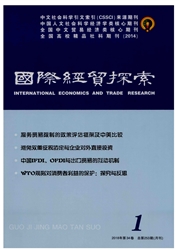

 中文摘要:
中文摘要:
文章利用世界投入产出表数据,基于全球价值链视角构建出相应修正的显性比较优势指数,并据此对1995~2011年中日两国制造业国际竞争力进行了比较分析。结果表明:(1)中日两国制造业均具有持续的显示性比较优势,且呈现出不断增强趋势。(2)期初中国制造业出口竞争力明显小于日本,但这种差距却在不断缩小并反超。(3)中国制造业中具有持续显示性比较优势的产业部门主要集中于技术水平相对较低的制造业,而日本则主要集中于技术水平相对较高的制造业。(4)中日两国制造业中,技术水平相对较高的制造业出口竞争力主要呈现出上升趋势,而技术水平相对较低的制造业则主要呈现出下降趋势。(5)中国低技术制造业始终保持最高的竞争优势,而日本则保持最低的竞争劣势。(6)中日两国中低技术制造业均保持较强的竞争优势,较为成功的融入到全球价值链中,但中国要显著低于日本。(7)中国中高和高技术制造业出口竞争力呈现出显著上升趋势,并由竞争劣势转为竞争优势,而日本则始终保持强劲的竞争优势。
 英文摘要:
英文摘要:
According to the modified revealed comparative advantage (RCA) index, the paper analyzes the international competitiveness of China and Japan's manufacturing industries using 1995-2011 world input-output tables (WIOTs). Our studies indicate that (1)China and Japan have made significantly comparative advantages, and present a rising trend. (2)China's comparative advantage of manufacturing industry is less than Japan's at the beginning of the period, but the gap is narrowing. (3)China's comparative advantage is concentrated in the field of low-tech manufacturing industry, while Japan's comparative advantage concentrated in the field of high-tech manufacturing industry. (~)The comparative advantage of high-tech manufacturing industry is strengthening, while the comparative advantage of low-tech manufacturing industry is weakening. (5)RCA indexes of China's low-tech manufacturing industry always maintain the highest, while RCA indexes of Japan's keep the lowest. (6)The medium & low-tech manufacturing industry of China and Japan, which has successfully integrated into the global value chain (GVC), has a strong competitive advantage, but China's RCA is lower than that of Japan. (7)The international competitiveness of China's high-tech manufacturing industry presents a rising trend from competitive disadvantage to competitive advantage, while that of Japan's keeps a stable competitive advantage.
 同期刊论文项目
同期刊论文项目
 同项目期刊论文
同项目期刊论文
 期刊信息
期刊信息
